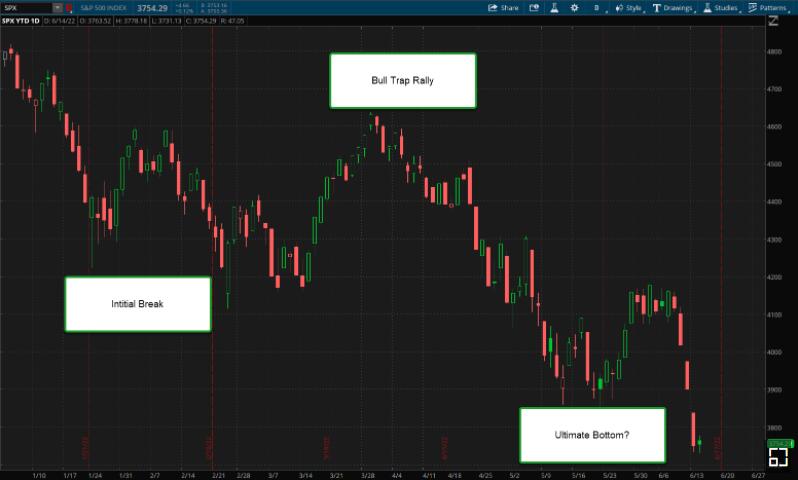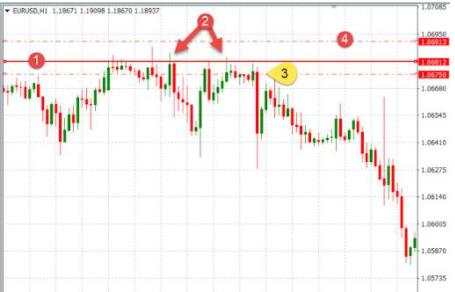what is a bull trap? A bull trap fools some traders into thinking a market or an individual stock price is done falling and that it’s a good time to buy. But then it turns out it’s not a good time, because the price soon resumes its descent, catching buyers in a money-losing trap. In many ways, it’s the opposite of a “bear trap,” which can fool traders into selling out too soon in the midst of a bull market.
What Makes Bull Traps Happen?
Bull traps can emerge after a market downturn appears to have been exhausted. In the wake of steep declines, there’s often clamoring among investors to grab an early seat for the ride back up, get in at what appears to be a bargain price, and/or pick a bottom.
These initial buying spurts may push prices above certain chart levels, and these “breakouts” can trigger more buying. But such breakouts may actually be false signals, and the price soon resumes a downward path.
Bull Trap Examples? Welcome to 2022
The S&P 500’s (SPX) retreat from all-time highs in January 2022 suggests investors had witnessed a bull trap weeks before this article’s publication date. The chart below tells the story.
Before the first downward leg of the slump in early January 2022, SPX was at a level of 4,800. Despite significant volatility along the way, the index fought its way up from the 4,100 level near late February to around 4,650 by the start of April.
Within this time frame, that pinnacle turned out to be the end of the diving board. Amid rising geopolitical tensions and inflation worries, bullish buyers would take a nearly 20% ride down to bear territory as of mid-June 2022, with more volatility to come (see Figure 1).

FIGURE 1: FOLLOW THE BOUNCING BULL. Investors might remember the first half of 2022’s market activity as the 2008 financial crisis in miniature. February’s start to the Russia-Ukraine war sparked sudden uncertainty that would help drive the S&P 500 (SPX-Candlesticks) down to nearly 4,100. An ensuing rally to April’s 4,600 level has looked like a bull trap ever since. Data source: S&P Dow Jones Indices. Chart source: The thinkorswim® platform. For illustrative purposes only. Past performance does not guarantee future results.
How to avoid the bullish trap?
There are several ways to identify and avoid bullish traps, and here are some of the most effective:
Volume: The key difference between a bull trap and a valid breakout to the upside is volume. If volume is low on the breakout, it is likely a bullish trap. Low volume usually occurs during periods of low volatility, meaning there are not enough sellers.
Uncertain Candlesticks: Another important signal of a bullish trap is the appearance of indeterminate candlesticks, such as dojis or spinning lines. If you see an uncertain candle chart after breaking through upwards, you should be cautious about opening long positions.
Retracement: Do not open a position immediately after an upward breakthrough, you can wait to see if there is a retracement. The market reverses back to a previously broken resistance level and encounters buying pressure, which means an influx of new buyers is pushing prices even higher. A pullback to previous resistance without support could be a bullish trap.
Multiple retests of resistance levels: Bullish traps can be identified by analyzing previous price action. If important resistance levels are constantly being retested, it means that buyers are not strong enough to push prices higher.
Market correlation: In addition to technical prices, experienced traders will also pay attention to cross-market correlations, such as the correlation between interest rates and bonds, gold and the US dollar, which will help identify bullish traps. For example, the Canadian dollar broke through an important resistance level, but the related crude oil price fell, which may mean that there is a bullish trap for the Canadian dollar.
Trade in the direction of fundamentals
Traders who trade only technical analysis may have a harder time identifying bullish traps than those who incorporate fundamental analysis.
A bullish trap looks like a very strong buy signal at first, and traders who combine fundamental analysis may find that some rises are not reasonable earlier, so they can realize the existence of the trap earlier.
Some fundamental data that can help identify subsequent market behavior include: earnings reports, central bank monetary policy, economic growth forecasts, inflation rates, interest rates, labor market statistics.
Bullish Trap Example Analysis
Bullish traps form in all financial markets. The following example is a bullish trap on the EUR/USD 1-hour chart, where the mark 1 is a strong resistance level, and the two arrows marked 2 point to a false upward breakthrough, which is a bullish trap:

If you look closely at the previous price fluctuations, you will find that the price has retested the resistance level several times, indicating that the buyers did not have enough strength to break through the resistance level. This is the first signal of a bullish trap.
Multiple indeterminate candles forming near resistance are the second signal, watch out for spinning lines, doji and pin bars that have formed at resistance.
All attempts to break above the resistance level were short-lived, the breakout lacked confirmation, and none of the candles successfully closed above the resistance level. This is the signal for the third trap.
Finally, the price made a strong bearish candle at callout 3, which provided an opportunity to sell with a stop loss at callout 4. In fact, the pair lost nearly 100 pips in the next few hours.
How to use bullish trap profitably?
While most people may be frustrated by bull traps, bull traps can also be seen as false breakouts that are actually good opportunities to trade in the opposite direction.
Here are some bullish trap trading tips:
Wait for candle confirmation: Once you identify a bullish trap, don’t go short immediately, it’s better to wait for the confirmation signal of the candle, such as bearish engulfing pattern, evening star pattern, etc.
Watch out for divergences: Sudden price increases and breakouts to the upside are often accompanied by divergences between price and oscillators such as the RSI. For example, if prices are making higher highs, but oscillators are making lower highs, then this is a divergence that traders should be aware of.
Watch out for cross-market correlations: If the correlated market doesn’t have the same upside breakout as the market you’re trading, it’s likely a bullish trap.
Avoid trading when liquidity is low: It is easy to form a bullish trap when liquidity is low. Although it is tempting to short after identifying a bullish trap, lower liquidity at this time will bring higher transaction costs and unstable price fluctuations, so it is better to choose to trade bullish traps when liquidity is higher. it is good.
Identifying Trend Reversals: Bullish traps often result in large and sustained price movements in the opposite direction, which can even lead to a trend reversal. Waiting for a clear signal of a trend reversal will significantly increase your chances of success trading bullish traps.
A bullish trap is also a false upside breakout, where the price reverses unexpectedly and breaks down through an important support level. The bullish trap is a headache for many traders, but after understanding it and mastering some techniques, we can still use it to reverse the trade and increase our chances of profit.
